Items filtered by date: January 2024
Complex Regional Pain Syndrome
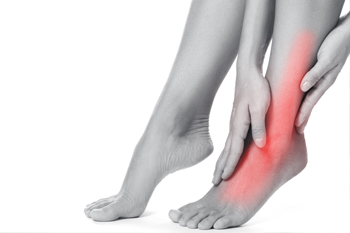
Complex regional pain syndrome, or CRPS, is a perplexing condition that often emerges in response to an injury, like a fracture, affecting limbs such as the foot. Its symptoms vary widely, encompassing burning pain, unpredictable intensity, loss of fine motor control, tremors, stiffness, and alterations in the skin, hair, and nails of the affected limb. The exact cause of CRPS remains elusive, but it predominantly impacts females. Diagnosis relies on medical history and symptom evaluation, as there is no definitive test. Misdiagnosis or delayed diagnosis can occur if medical professionals are unfamiliar with CRPS, emphasizing the need for chiropodists in its recognition. Treatment is multifaceted, involving medication, physical therapy, counseling, psychological support, and intervention therapy like nerve blocks. Preventing relapses may involve specific anesthetics and pain medications. If you have symptoms in your feet as described above, it is suggested that you schedule an appointment with a chiropodist for a proper diagnosis and treatment.
Foot pain is a common problem treated by chiropodists. If you have foot pain, please consult with one of the chiropodists from Complete Family Footcare & Therapy. Our clinicians can help you maintain the health of your lower limbs and your mobility.
When you are experiencing foot pain, it’s important to note the type of pain and its location, as this can help determine a diagnosis.
Pain in the top of the foot may be caused by:
-
Stress fractures
-
Sinus tarsi syndrome
-
Extensor tendonitis
-
Tibialis anterior tendonitis
-
Gout
-
Athlete’s foot
-
Ganglion cysts
Pain in the bottom of the foot may be caused by:
-
Plantar fasciitis
-
Foot cramps
-
Tarsal tunnel syndrome
-
Plantar fibromatosis
-
Posterior tibial tendonitis
-
Stress fractures
-
Flat feet
Pain on the side of the foot may be caused by:
-
Ankle sprain
-
Cuboid syndrome
-
Peroneal tendonitis
-
Stress fractures
-
Bunions
-
Corns or calluses
-
Posterior tibial tendonitis
Heel pain may be caused by:
-
Plantar fasciitis
-
Achilles tendonitis
-
Bone spurs
-
Heel fractures
-
Retrocalcaneal bursitis
-
Sever’s disease
Pain in the toes may be caused by:
-
Gout
-
Hammertoe
-
Turf toe
-
Bunions
-
Ingrown toenails
-
Blisters
-
Arthritis
These and many more conditions can be treated by a chiropodist. If you have any questions, please feel free to contact our offices located in . We offer the newest diagnostic and treatment technologies for all your foot care needs.
Facts About Athlete’s Foot
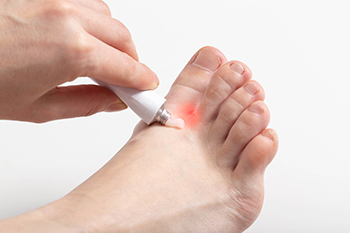
Athlete's foot is a common foot infection caused by a fungus that may enter the skin through cuts, cracks, or sores. Athlete's foot spreads through contact with infected people, sharing towels, or walking barefoot in communal spaces, like shower stalls or public locker rooms. Individuals with poor foot hygiene, such as infrequent washing or changing socks, face an elevated risk of developing athlete’s foot. Symptoms include cracks or blisters, redness, swelling, and itching on the feet's bottoms or sides. Additional symptoms are a burning sensation, scaly or peeling skin, bad odor, and abnormal toenails. Diagnosis involves visual examination by a chiropodist or analysis of a skin sample under a microscope to identify the specific fungus. Treatment typically consists of antifungal medicines in cream or pill form, with the importance of completing the prescribed medication even if symptoms improve. Early detection of athlete’s foot symptoms and proper care of the infected feet are paramount, as the infection is extremely contagious. If you believe you have athlete’s foot, it is suggested that you schedule an appointment with a chiropodist as quickly as possible for an exam and treatment.
Athlete’s foot can be uncomfortable and unsightly. To learn more about preventing and treating this condition, please consult with one of the chiropodists from Complete Family Footcare & Therapy. Our clinicians will assess your condition and provide you with quality foot and ankle treatment.
What Is Athlete’s Foot?
Athlete’s foot refers to an infection of the skin on the feet that is caused by a fungus. This fungus is contagious and thrives in warm and moist environments. It is often spread in common areas such as public pools, locker rooms, and showers. It can also spread when sharing personal items, like shoes or towels, with an infected person.
Symptoms
The symptoms of athlete’s foot may include:
-
Itching, stinging, or burning of the skin on the feet
-
Cracking or peeling skin, especially between the toes and on the soles of the feet
-
Scaly, red rash on the foot
-
Blisters
-
Foul odor
Treatment
Treatment for athlete’s foot typically involves using over-the-counter topical antifungal medications on the feet. When over-the-counter options are ineffective, you may need to take prescription oral medications or topical antifungal drugs, or a combination of both.
Prevention
Preventing athlete’s foot places an emphasis on good foot hygiene practices.
You can prevent athlete’s foot by:
-
Washing and drying your feet thoroughly every day
-
Wearing shoes when walking in public areas
-
Not sharing personal items, like shoes or socks, with others
-
Wearing shoes and socks made out of breathable materials
If you have any questions, please feel free to contact our offices located in . We offer the newest diagnostic and treatment technologies for all your foot care needs.
Sever’s Disease and Active Children
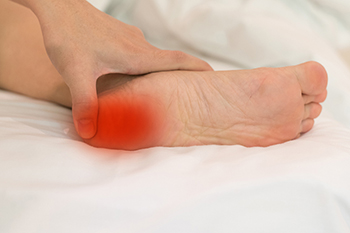
Sever's disease, a condition, not truly a disease, but rather a growth-related injury, is prevalent among active children experiencing growth spurts. Also known as calcaneal apophysitis, this ailment targets the growth plate in the heel bone, where the Achilles tendon attaches. The growth plate is a vulnerable area during periods of rapid bone development, and repetitive stress or strain can lead to inflammation and discomfort. Typically occurring in children aged eight to 14, Sever's disease manifests as heel pain, often exacerbated by physical activities such as running or jumping. As bones grow faster than muscles and tendons, the strain on the heel becomes pronounced. Understanding Sever's disease involves recognizing its connection to growth, acknowledging the importance of wearing supportive footwear, and incorporating sufficient rest into a child's active routine. While the condition is self-limiting and can resolve with time, a chiropodist’s advice is often sought. If your active child has heel pain, it is suggested that you consult with this type of doctor who can offer appropriate relief remedies.
Sever’s disease typically affects young children and teenagers. If your child complains of foot pain, please consult with one of the chiropodists from Complete Family Footcare & Therapy. Our clinicians will assess your condition and provide you with quality foot and ankle treatment.
What Is Sever’s Disease?
Sever’s disease, also known as calcaneal apophysitis, is an inflammation of the growth plate in the heel bone. It is typically caused by overuse due to repetitive activities such as running, jumping, and playing certain sports. This condition most frequently affects children between the ages of 8 and 14.
Symptoms
Symptoms of Sever’s disease include:
-
Pain in the back or bottom of the heel
-
Pain when the sides of the heel are squeezed
-
Limping or walking on tiptoes to avoid putting pressure on the heel
-
Difficulty running, jumping, or participating in usual activities
-
Fatigue
Diagnosis
Sever’s disease is diagnosed by taking a thorough medical history and performing a physical examination. Imaging studies, such as an X-ray, can help rule out other injuries like a fracture.
Treatment
Sever’s disease typically heals without any long-term complications. Treatment involves resting the affected foot by reducing typical activities, wearing orthotics to support the foot, immobilizing the affected foot, taking medications to reduce pain and inflammation, and stretching the foot.
If you have any questions, please feel free to contact our offices located in . We offer the newest diagnostic and treatment technologies for all your foot care needs.
Tips for Happy Feet in Winter
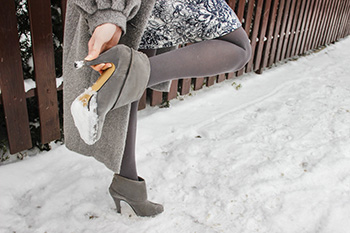
It is tempting to overlook your feet during the winter months as they are nestled away in boots and socks. However, neglecting foot care during winter can lead to various issues, from cracked skin to fungal toenail infections. To ensure your feet stay happy and healthy, start by choosing appropriate winter footwear that provides warmth without compromising circulation. It helps to steer clear of non-breathable materials to control foot sweat. Equally important is the selection of breathable socks, such as wool, to keep feet warm and dry, preventing over-saturation. Promptly remove wet shoes and socks to avoid fungal and bacterial infections, ensuring thorough drying before reuse. Combat the drying effects of winter air and heaters by regularly applying a high-quality foot cream to prevent corns, calluses, and cracked heels. Consider giving your toenails a break from polish during winter to allow better absorption of moisturizing creams and deter nail dryness, especially if your usual lacquers contain yellowing agents. If you have developed heel fissures or fungal toenail infections during the winter, it is suggested that you schedule an appointment with a chiropodist for treatment.
The winter months can bring about new or worsening foot and ankle problems. If you’re suffering from foot or ankle pain, please consult with one of the chiropodists from Complete Family Footcare & Therapy. Our clinicians can help you maintain the health of your lower limbs and your mobility.
Winter Foot Problems
-
Cracked heels - Dry, cracked skin on the heels of the feet that is associated with cold, dry weather
-
Athlete’s foot - A fungal infection on the skin of the feet
-
Blisters - Fluid-filled bubbles of skin that usually form in response to friction
-
Fractures - Broken bones in the feet or ankles
-
Metatarsalgia - General foot pain
-
Chilblains - Spasming of the small blood vessels in the toes in response to exposure to cold weather
-
Raynaud’s disease - Numbness, pain, and color changes in the toes due to cold weather
Prevention
-
Wear warm socks and shoes
-
Avoid prolonged exposure to the cold
-
Moisturize the heels regularly
-
Keep your feet clean and dry
-
Walk carefully in areas that may be icy
-
Wear non-slip shoes
If you have any questions, please feel free to contact our offices located in . We offer the newest diagnostic and treatment technologies for all your foot care needs.
We Can Treat Your Foot or Ankle Pain
Causes and Symptoms of Bunions
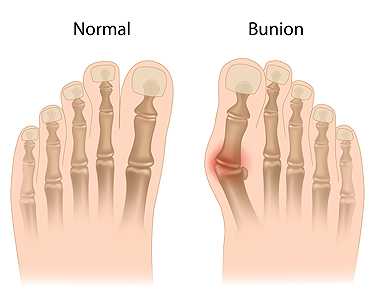
If you have ever noticed a bony protrusion at the base of your big toe, you could be dealing with a bunion. This common foot condition occurs when the first metatarsal bone gradually shifts sideways, causing the front of the foot to widen and the big toe to lean towards its companions. Symptoms can include pain at the bulging joint, along the bottom of the foot, or in the toes. The pain may become worse by wearing ill-fitting shoes, especially those that are too tight. In severe cases, bunions can lead to nerve damage, resulting in numbness, and the skin on the sole may become thick and hardened. Beyond the immediate discomfort, bunions can elevate the risk of osteoarthritis in the big toe joint, leading to chronic pain and potential instability. Genetics, weak connective tissue, and having a short Achilles tendon can contribute to the formation of bunions. In addition, short calf muscles or joint diseases such as rheumatoid arthritis can increase the risk. If you suspect you have a bunion, it is suggested that you seek the advice of a chiropodist who can help you to manage the symptoms, and mitigate the risk of complications.
Bunions progressively worsen over time and may cause walking in your shoes to become difficult. To learn more about bunions, please consult with one of the chiropodists from Complete Family Footcare & Therapy. Our clinicians will assess your condition and provide you with quality foot and ankle treatment.
What Are Bunions?
A bunion is a bony bump that protrudes from the base of the big toe. Bunions are caused due to a misalignment of the first metatarsal. The characteristic bump of a bunion forms when the metatarsal shifts outwards from its proper position. Bunions develop slowly over time and progressively worsen without treatment. The skin over the bunion may develop calluses due to the friction from shoes. Eventually, a bunion can make walking uncomfortable or even painful. Bunions are one of the most common foot deformities and are especially common in women and older adults.
Symptoms
A bunion appears as a bulging bump on the outside of the base of the big toe.
The bunion may also:
-
Be swollen, red, or sore
-
Develop corns or calluses over it
-
Cause pain
-
Limit the big toe’s range of motion
Treatment
There are several different treatments available for bunions. Conservative treatment options include wearing shoes with a wider toe box, cushioning the bunion with a specialized pad, wearing shoe inserts, icing the bunion if it becomes inflamed, and taking medications to relieve pain. In more severe cases, more invasive procedures may be done. This may involve removing the swollen tissue around the bunion, straightening the big toe, realigning the bones at the front of the foot, or a combination of these procedures.
If you have any questions, please feel free to contact our offices located in . We offer the newest diagnostic and treatment technologies for all your foot care needs

